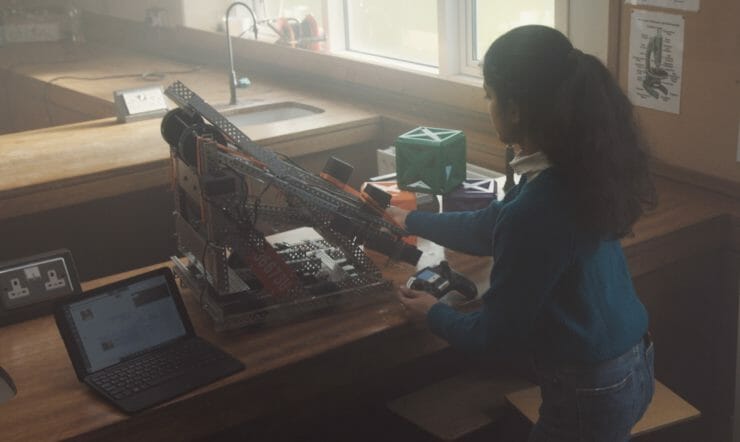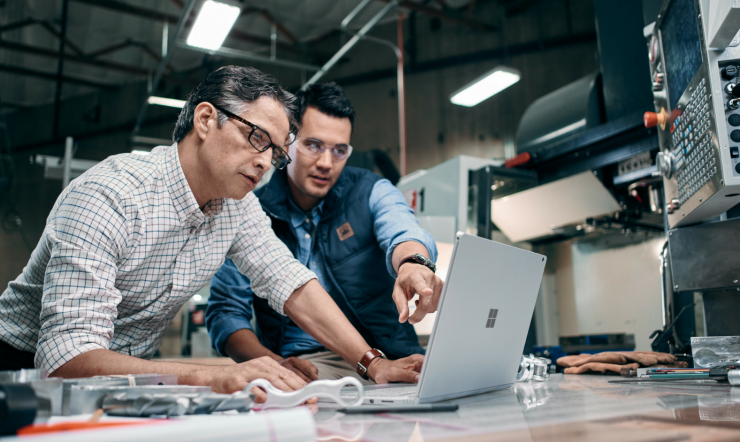Irish rural secondary school has boosted sustainability and increased collaboration, while building a deep culture of trust through its innovative approach to education.
Sustainability and promoting collaboration are vital goals in education today. Sacred Heart Secondary School in Tullamore, Co Offaly is achieving both by harnessing the transformative power of digital tools in education.
“We now offer our students education on the student’s terms for the first time ever,” says school principal Pauline McKenna. “They get a device and immediately start to collaborate with their class mates on a platform with which they are really familiar and comfortable. We are always exploring new ways to learn and share knowledge”.
“We offer education on the student’s terms”
Rather than the old-fashioned, one-way mode of a teacher addressing a class, students and staff at Sacred Heart are taking a different approach by working together, using Surface Pro 2 Devices and Microsoft Office 365 tools.
“We are able to sustain an environment of change and innovation in our school because of our use of Microsoft software and devices.”
A dramatic move to sustainable education
The school now uses over 80% less paper than it did five years ago and has also cut its use of toner cartridges, pens and related packaging accordingly. Almost none of the students use paper textbooks.
That has transformed the sustainability profile of the school and has also freed up budget for the creation of more teenage-friendly classrooms and congregation areas, explains Pauline. “Now, when you walk through this school, you see it as a modern, teenage environment. It’s all part of rethinking education.”
“Teachers’ average annual continuous professional development (CPD) hours skyrocketing to 36, from seven hours previously”
Sustaining staff to be at their best
Furthermore, the school is causing fewer carbon emissions. For example, teachers no longer have to travel 90km to attend in-person training in a hotel. Instead, they attend webinars, which has seen their teachers’ average annual continuous professional development (CPD) hours skyrocketing to 36, from seven hours previously.
“The pace of curricula change is faster now and the challenges in the student cohort are more complex,” says Pauline. “To keep great staff, we need to sustain them and support them to flourish through CPD. That is where we can nurture them and keep feeding their knowledge.”
Enabling students to learn at their own pace
The transition to digital learning has also given students a sense of control and creativity over their own work, while also raising the average reading age of students.
Being able to access recordings of teachers explaining complex topics has proven empowering for them and they appreciate being able to access this knowledge after class. “The technology empowers students to take control of their own education. It’s not a one-size-fits-all anymore”, notes Pauline. It also saves teachers time in having to spend additional one-to-one time with students who may have been absent or find the topic challenging.
“The technology empowers students to take control of their own education. It’s not a one-size-fits-all anymore.”
As staff and students use OneNote heavily, the teachers are also pleased to have moved on from the days of constantly carrying heavy bags of paper notes and copy books.
In fact, students and staff across the school make the most of Office 365, and in particular, Microsoft Teams, Forms, FlipGrid, as well as Minecraft.
Access to expertise and support
Throughout Sacred Heart’s move to digital-first, which began nine years ago, the school has liaised with Microsoft and partner Wriggle. Stephen Eustace, a Surface specialist for the public sector at Microsoft, advises on the school’s use of devices and helps to shape staff training.
“I maintain regular contact and provide insight and updates into what is happening in education,” he says, “ensuring they maximise the value from their membership in the Microsoft Showcase community and highlight the great work that happens in the school.”
Fostering parent-school relationships
With parent-teacher meetings now online, parents are saved from having to drive to the school and queuing over two to three hours to see teachers. Moreover, all communications from the school to parents are online, saving postage and administration time.
The real benefit in going digital-first, however, has been how it has enabled the school to build deep trust with parents. “It was a lot to ask parents to buy into this at a small rural school five years ago,” says Pauline. “Now the school is really trusted to make decisions.
“We have proven ourselves, as really good relationships with parents have been maintained during the pandemic. They trust us and know we will be moving on to tackle the next big thing,” she adds.
“We tell them, ‘Innovative things will be happening in your daughter’s classroom’, and that culture of innovation has absolutely increased their trust in us.”
Shaping resilient and future-ready students
“Enjoying a digital-first education also prepares students for adult life more broadly”, adds Pauline, “especially given the relentless pace of change we all face.
“When you have this level of innovation with students, you already have kids who are not afraid of change, because every day they are doing something different. It is all about mindset.
“The introduction of one small device changed many cultures and practices in our school. As a result, we are preparing young women to go into a world that will be totally shaped by change and most of them will be very well able to manage that change.”
Learn how your school can reimagine education in a new era of digital learning.

























